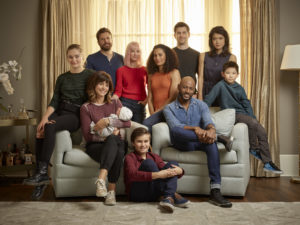Mindful Self-Compassion: How to Soothe Yourself
If you’re reeling from a DNA surprise, you may be no stranger to confusion, anger, and sadness. If you’re searching for family or have been in reunion, you might tumble through emotional highs and lows. If you’ve felt rejected, it may be hard not to believe you’ve done something wrong—that you are wrong. And if you’re suffering from trauma associated with genetic identity issues, you may have moments of soul-crushing anguish and criticize yourself for what seems an inability to cope. Others, you think, might handle this better. No one else, you believe, is suffering in quite this way, and so you conclude you’re flawed, incapable, unworthy. You might feel ashamed, embarrassed, even guilty.
Although your distress is real, some of these responses may not be rational since you aren’t the cause of the turmoil in your life. But they’re also not uncommon. They’re human. But in the midst of it, it may seem to you that only you react this way.
If someone you know were in such distress, you’d likely open your heart and be gentle with their emotions, counter their hard feelings with softness, assure them they’re not alone in their suffering, that it’s not a reflection of them. Rather than deliver judgment or harsh criticism, you’d offer kindness and support.
But what do you do for yourself? Many of us know how to show compassion to our loved ones who are going through difficult times or are beset by sorrows, but when it comes to offering ourselves the same gentleness, we often fall short. It doesn’t even occur to us that we can be kind to ourselves.
Mindful self-compassion, as the name suggests, is a skill and practice that merges mindfulness and self-compassion to help you build resilience and develop the ability to respond to negative emotions in the same supportive, compassionate manner as you would to another’s troubles. Developed by an expert in mindfulness and a leading researcher of self-compassion, Christopher Germer, PhD, and Kristin Neff, PhD, it relies on the synergy of the two components, both of which derive from Buddhist teaching and psychology. Mindfulness allows us to be in the present moment, aware and without judgment, noticing our emotions without evaluating them, while self-compassion—an attitude of kindness toward oneself and an appreciation of one’s own suffering—is a practice that can be used to soothe ourselves in difficult times.
For Neff, who describes herself as a self-compassion evangelist, these ideas percolated more than 20 years ago when she hit a rough patch in life. In a YouTube video, she explains that when she was a PhD student at UC Berkeley, she was going through a divorce and feeling overwhelmed by shame, stress, and self-criticism. She turned to meditation, but in her first lesson, her instructor drove home the importance of self-compassion. At the same time that she was working with a key researcher in the field of self-esteem, Neff became aware of the limitations of self-esteem and the greater benefits of self-compassion. While self-esteem involved judgment and placing oneself above others, self-compassion involved neither harsh self-evaluations nor the need to stack oneself up against others. It was all about self-acceptance, despite flaws or weaknesses.Mindful self-compassion isn’t a tool with which to solve your problems or eliminate unpleasant circumstances. It’s more a means by which you can take a “time out” from judgment—away from stress and rumination—to offer yourself comfort and unconditional acceptance. Neff describes it as comprised of three key concepts:
- Self-kindness: treating oneself with gentleness and understanding rather than with self-judgment and criticism
- Common humanity: Understanding that our suffering is neither unique nor driven by our imperfection, but rather is a consequence of being human, a condition of which is imperfection
- Mindfulness: a midpoint between ignoring our emotions and ruminating on them; being aware without judging
Separately, mindfulness and self-compassion have been shown to offer health and wellness benefits. Combined they can transform our reactions to hardship and help us build resilience. Research has shown that completion of a mindful self-compassion program reduces anxiety and depression and increases happiness, motivation, ease in life, and compassion to others and to ourselves. Neff and Germer’s Center for Mindful Self-Compassion offers a variety of mindful self-compassion programs and workshops, including an eight-week program and a five-day intensive. It also offers live online programs and a directory to teachers in your area. The principles and practices are also available in Neff and Germer’s book, “The Mindful Self-Compassion Workbook.”We talked to Lesley Huff, PsyD, a licensed psychologist and certified teacher of mindful self-compassion at the Samaritan Counseling Center in Lancaster, Pennsylvania, about how mindful self-compassion may help individuals struggling with issues related to identity, rejection, anger, shame, betrayal, and anxiety.
Mindful self-compassion, she says, “offers practices that bring a relationship of kindness to whatever we are experiencing. If we understand that life is filled with both pain and joy, we can accept the pain as it arises and not fight against it. While experiencing pain, we can use the mindfulness practices to hold it with some curiosity and better understand its source and message. The compassion practices first support us in tolerating the pain while we sit with it and second remind us to reflect on what we need given the pain.”
If you’re trying to eliminate pain, a recommendation to let it be may seem counterintuitive and undesirable. But, says Huff, it’s a path forward. She reminds her students and clients that sitting in dis-ease is uncomfortable, but adds that it’s more beneficial than knee-jerk reactions and efforts to eradicate it. “It’s more fruitful than trying to quickly resolve it and move out of the pain,” she says. “Our methods of moving out of the pain usually include things that cause more suffering, such as looking for someone to blame (ourselves or someone else), making quick and ill-informed decisions, and numbing. It’s also important to remember that we use the practices of mindful self-compassion not to feel better, but because we feel bad. This is often hard for students to wrap their minds around since as a society we do everything to ‘feel better.’ Eventually we will feel better (since all things are temporary), but while we get through the tough parts, it’s more productive to hold ourselves with kindness and not make things harder through unnecessary suffering.”Mindfulness—nonjudgmental awareness—helps you recognize your pain, says Huff. “’You cannot heal what you cannot feel,’ as the saying goes. At the same time, there are ways in which we can cultivate compassion in all areas of our lives (physically, mentally, emotionally, relationally, spiritually) that will hopefully become more habitual (albeit still intentional). If we understand that a lot of suffering comes from walking through the world in a trance, then bringing more awareness through mindfulness helps us to see things more clearly, respond more intentionally, and reduce our tendency to create suffering.”
Self-compassion alone, while soothing, doesn’t necessarily increase awareness. Surprisingly, Huff explains, when people focus on becoming more compassionate, there may be “more of an absence of harmful behavior than really overt compassionate behavior. For example, someone may miss noticing that they were less reactive to a person/situation unless they really think about it.” The mindfulness component provides the awareness.Neff has written that informal practices are as effective as formal practices. We asked Huff about the difference between the two. “There’s a tendency to idolized formal practice over informal practice,” she says. “Formal practice is when one sets aside specific time to sit and meditate. The three core practices of mindful self-compassion, which can be practiced formally, are affectionate breathing, loving kindness toward ourselves, and giving and receiving compassion. Affectionate breathing is similar to the mindfulness practice of anchoring awareness on our breath, but with the addition of fostering a quality of tenderness toward ourselves through the breath. Loving kindness, or metta meditation, is the practice of anchoring on kind words toward ourselves. This can also be done by including wishes of goodwill to others. Giving and receiving compassion is another breath exercise that anchors using words and some visuals. Receiving on the in-breath and giving on the out-breath is a wonderful metaphor reminding us that you need to receive (inhale) in order to give (exhale). Like any activity, such as sports or playing an instrument, formal practice makes it easier to draw on these practices in daily life. I think the real practice is to use them informally. It seems like a waste to only be kind when we are sitting on a cushion meditating. It’s more about how we move about the world. Therefore, as Kristin noted, if all you remember to do is to breathe and be less reactive in the grocery store check-out line, but have difficulty making time to sit formally, then you are really making a difference in your life and the world in general.”Among the troubling aspects of learning about a change in family status through a DNA surprise is that many individuals find their friends and family lack compassion and understanding. They may be made by others to feel as if they’re blowing things out of proportion—that they’re troubled by what others perceive as insignificant. Since they already may be feeling that their concerns are invalid, might that be an impediment to embracing self-compassion?
“Humans are empathic creatures,” says Huff. “When we observe someone else in pain, our tendency is to want to fix it and make it go away since it’s causing pain for us too. Our biology motivates us to avoid pain and move toward pleasure. We have received very unhelpful messages from society that offering advice, sharing a comparative story, or giving someone ‘perspective’ are what we ‘should’ do in respond to someone’s pain. Of course, our biology aligns nicely since we don’t really want to sit with their pain anyway.”
It’s possible, Huff observes, to help others become better listeners and be more responsive to your needs. “We have a terrific exercise in the mindful self-compassion class to foster compassionate listening. Before the exercise, the majority of my students express awkwardness and discomfort with the idea of sitting silently while someone shares a story of pain. They feel they are being horrible people. However, after the practice, their perspective really shifts. The experience of talking and not having someone jump in or offer a tissue in response to tears is most often experienced as tremendously freeing and healing by the person sharing their story. When they are the ones listening, students are encouraged to use the mindful self-compassion practices to soothe their discomfort internally so they don’t disrupt the space. This still feels uncomfortable because it’s unfamiliar. At the same time, the realization of the gift of holding space for someone encourages us to work on managing one’s urge to fix. So, I encourage individuals to let others know what they need. For example, they can tell their loved ones that they just need them to listen and to not offer advice or ‘fix’ the situation. Additionally, both the individuals who have realized this new information and their family members can benefit from seeking counseling so they can have a space to air their pain, knowing the professional is trained to manage their discomfort so they can create safety for the client.”Mindful self-compassion not only soothes distress; it also empowers those who practice it. “Having compassion for ourselves allows us to sit in the pain without needing to reactively fix it,” Huff explains. “Our methods of moving out of the pain usually include things that cause more suffering, such as looking for someone to blame (ourselves or someone else), making quick and ill-informed decisions, and numbing. Additionally, when we are able to offer compassion to ourselves, we realize our own power, rather than waiting for someone else to offer it to us. In reality, everyone is just bumbling along trying our best to navigate the messiness of being human. Self-compassion is tremendously responsible because we take care of ourselves rather than look to others to do it for us. Then we can receive and enjoy what people can offer with less judgment and expectation. Last, the more we are compassionate toward ourselves, the more we can develop compassion for others. Judgment toward ourselves is a sword that cuts both ways.”If you are unable to participate in a mindful self-compassion class or workshop, you can still learn the concepts and develop your own practice. There are numerous resources available, and Huff shares some of her favorites.
Books: Those by Kristin Neff, Chris Germer, and Brené Brown. Additionally, “Real Love” by Sharon Salzberg; “Radical Acceptance” by Tara Brach; ‘Hidden Wholeness” by Parker Palmer; “When Things Fall Apart” by Pema Chödrön; and poetry by Mary Oliver, John O’Donohue, David Whyte, and Tony Hoagland.
Podcasts: There are several episodes of the podcast “On Being with Krista Tippett” that touch on topics of mindfulness and compassion.
Apps: Insight Timer; Stop, Breathe, Think; Headspace; Calm; Chill.




